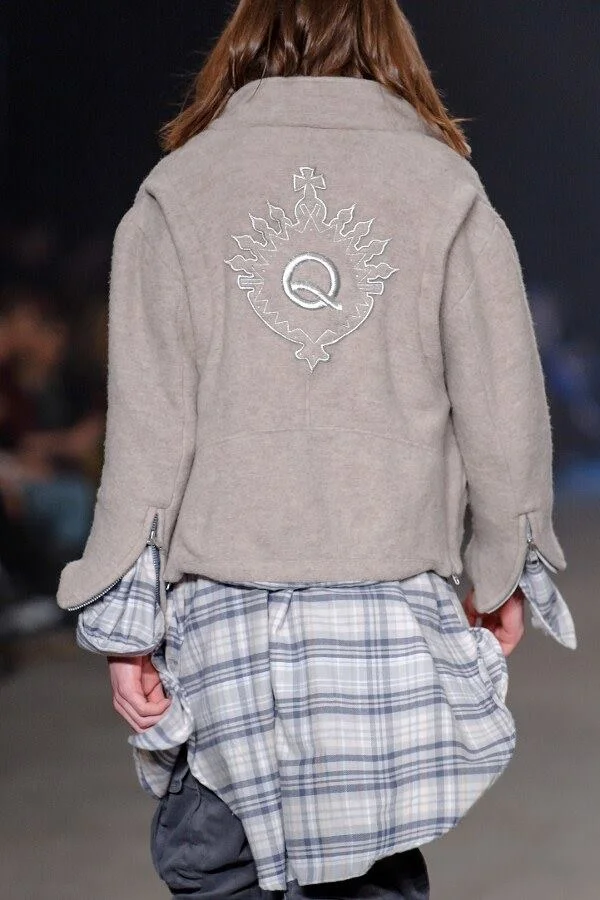Kupisz has his own unique interpretation of Polish patriotic symbols. Designer combines them with sleek and sexy modern fashion
Eagles, Emotions and Anarchy
Robert Kupisz’s Anarchy collection, s/s 15 ©Akpa, courtesy of Robert Kupisz
Designer Robert Kupisz has his own unique interpretation of Polish patriotic symbols. In Poland, as in other countries, these patriotic symbols are increasingly being appropriated by xenophobes and extreme nationalists, but Kupisz combines them with sleek and sexy modern fashion to great effect.
The designer’s Polish eagle T-shirts became a smash hit during the Euro 2012 championships which took place in Poland and Ukraine. Kupisz had set out to design an alternative to the banal football fan merchandise and the nationalistic version of Poland’s cherished emblem. The eagle T-shirts come from Kupisz’s Heroes collection (A/W 13), which refers to the Warsaw Uprising. During the armed struggle in 1944, the Nazis murdered between 150,000 and 200,000 Varsovians and reduced the city to ruins. Kupisz’s delicate, dreamlike Heroes collection was also inspired by the wartime poetry of Krzysztof Kamil Baczyński, who perished in the battle for his beloved city. Kupisz refined his collection by combining military, war and patriotic motifs with the fashion of the early 1940s and elements of grunge. This combination proved controversial.
eagle T-shirts and Heroes fashion show (photo akpa)
In a subsequent collection, Anarchy (S/S 15), Kupisz promoted the concepts of pacifism and freedom. The show took place shortly after celebrations to commemorate the 25th anniversary of the fall of communism. The soundtrack began with a conversation between some punks: the guys (not without a little pride) complained that they had been labelled slobs, sons-of- bitches and trash, that they had been thrown out of churches because of their appearance. In the communist era, it was not just the ire of schools, the churches and the local community that Polish punks had to face-their main opposition came from the oppressive organs of the state. The punk rock music accompanying Kupisz’s show instantly sent the audience back to the 1980s, to the famous Jarocin Festival, a mainstay of musical and moral freedom in those days. Studs, zips and torn clothing all made an appearance on the catwalk, as did balaclavas, anarchy symbols and T-shirts with crossed-out missiles on them. The show, which took place just as the Russia-Ukraine conflict was beginning to intensify, clearly related to the problems with freedom we face today.
Anarchy fashion show, photo Akpa
Robert Kupisz may tackle difficult subjects, but his main focus is on happiness and a range of human emotions. Dreams are important, and Kupisz’s lives his life fulfilling one dream after another. He first studied at art school and then went on to do pedagogical studies in Kielce. Then he worked as a professional dancer. After that, having trained at the Toni&Guy Academy in London, he became a hair stylist and did work for Vogue, L’Officiel and GQ. He also worked with the Paris Opera and directors Krzysztof Warlikowski and Jerzy Skolimowski. Finally, in 2011, he became creative director of the Robert Kupisz label, which has since become one of the most powerful companies in Poland.
Testosterone and a powerful femininity are key concepts in Kupisz’s collections. Patriotic elements are juxtaposed with rock, hip-hop and kitsch, while lions and eagles are symbols of strength, and Kupisz combines his favourite sport with hard deconstructed silhouettes. Robert Kupisz has created a style which is both individualistic and instantly recognisable.
Robert Kupisz wearing his Tango collection, Art Director / Photo: Zuza Krajewska
Robert Kupisz Fall 2017/18 collection was inspired by Tatry – Polish-Slovakian mountains, photo Marek Makowski

























